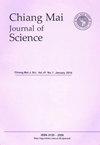Advancing Sustainable Solutions: Exploring United Atom Model for Efficient Molecular Dynamics Simulation of Poly-ethylene Vanillic (PEV) Polymer
IF 0.6
4区 综合性期刊
Q3 MULTIDISCIPLINARY SCIENCES
引用次数: 0
Abstract
The development of green polymers is a crucial long-term solution to address the problem of plastic waste. In particular, the bio-based polymer polyethylene vanillic (PEV) has garnered interest due to its comparable mechanical and thermal properties to polyethylene terephthalate (PET), a widely used single-use plastic. Molecular dynamics (MD) simulations are commonly employed to study the molecular structure and dynamic properties of materials, offering cost-effective applications. However, the accuracy of MD simulation results heavily relies on the chosen force field model. The all-atom (AA) force field, while providing insights into molecular interactions, demands significant computational resources, especially for large systems like polymers. This study aimed to employ the united atom (UA) model with revised OPLS-UA force field parameters for the biopolymer PEV, aiming to reduce computational time in dynamic and physical investigations. Consequently, the UA model successfully folded the PEV polymer in a manner resembling the single-chain PEV treated with the AA model, while also predicting a glass transition temperature (Tg) close to the experimental value of 348 K. These findings underscore the potential of the UA model for simulating PEV and its promising implications.推进可持续解决方案:探索用于高效分子动力学模拟聚乙基香草酸(PEV)聚合物的联合原子模型
开发绿色聚合物是解决塑料垃圾问题的重要长期解决方案。特别是生物基聚合物香草醛(PEV),由于其机械性能和热性能与广泛使用的一次性塑料聚对苯二甲酸乙二醇酯(PET)相当,因此引起了人们的兴趣。分子动力学(MD)模拟通常用于研究材料的分子结构和动态特性,具有成本效益。然而,分子动力学模拟结果的准确性在很大程度上取决于所选择的力场模型。全原子(AA)力场虽然可以深入了解分子间的相互作用,但需要大量的计算资源,尤其是对于聚合物等大型系统。本研究旨在针对生物聚合物 PEV 采用经修订的 OPLS-UA 力场参数的联合原子(UA)模型,以减少动态和物理研究中的计算时间。结果,UA 模型成功地折叠了 PEV 聚合物,其折叠方式与用 AA 模型处理的单链 PEV 相似,同时还预测了接近实验值 348 K 的玻璃化转变温度(Tg)。
本文章由计算机程序翻译,如有差异,请以英文原文为准。
求助全文
约1分钟内获得全文
求助全文
来源期刊

Chiang Mai Journal of Science
MULTIDISCIPLINARY SCIENCES-
CiteScore
1.00
自引率
25.00%
发文量
103
审稿时长
3 months
期刊介绍:
The Chiang Mai Journal of Science is an international English language peer-reviewed journal which is published in open access electronic format 6 times a year in January, March, May, July, September and November by the Faculty of Science, Chiang Mai University. Manuscripts in most areas of science are welcomed except in areas such as agriculture, engineering and medical science which are outside the scope of the Journal. Currently, we focus on manuscripts in biology, chemistry, physics, materials science and environmental science. Papers in mathematics statistics and computer science are also included but should be of an applied nature rather than purely theoretical. Manuscripts describing experiments on humans or animals are required to provide proof that all experiments have been carried out according to the ethical regulations of the respective institutional and/or governmental authorities and this should be clearly stated in the manuscript itself. The Editor reserves the right to reject manuscripts that fail to do so.
文献相关原料
| 公司名称 | 产品信息 | 采购帮参考价格 |
|---|
 求助内容:
求助内容: 应助结果提醒方式:
应助结果提醒方式:


